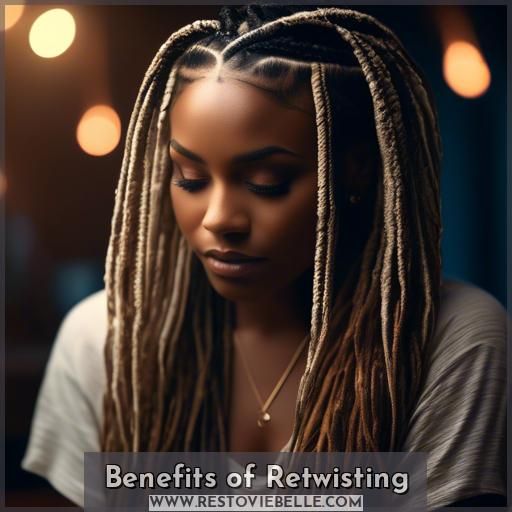This site is supported by our readers. We may earn a commission, at no cost to you, if you purchase through links.

You should retwist your locs every 4-6 weeks for maximum well-being and presentation.
This schedule allows for new growth while avoiding excessive handling that can lead to breakage.
However, you’ll need to adjust based on your hair’s growth rate, porosity, daily activities, and washing routine.
Finer textures may need more frequent retwisting.
Protecting locs during showers and properly caring for them at night can help extend intervals.
Ongoing neglect results in thinning roots, loc merging, and an untidy appearance.
Adhering to this general timeline and paying attention to your hair’s individual requirements is essential – keep reading to uncover the key factors that determine your ideal retwist schedule.
Table Of Contents
- Key Takeaways
- How Often Should You Retwist Locs?
- How Often Should You Retwist Your Locs?
- Factors Affecting Retwist Frequency
- Determining Your Retwist Schedule
- Extending Retwist Intervals
- Self-Retwisting Techniques
- Signs of Retwist Need
- Consequences of Not Retwisting
- Benefits of Retwisting
- Retwist Frequency Based on Loc Phase
- Retwist Frequency Adjustments
- Frequently Asked Questions (FAQs)
- How often should I retwist my locs during the starter phase?
- What is the recommended frequency for retwisting locs in the budding phase?
- How long should I wait between retwists during the teen phase of loc growth?
- What is the ideal retwist frequency for mature locs in the rooted phase?
- How can I determine if my locs are ready for a retwist?
- Conclusion
Key Takeaways
- Retwist locs every 4-6 weeks for maximum well-being and presentation.
- Adjust retwisting frequency based on hair growth rate, washing routine, and daily activities.
- Factors such as hair texture, loc phase, and lifestyle also contribute to determining the frequency of retwisting.
- Regular retwisting prevents hair from becoming sparse, tangled, or unpresentable, ensuring healthy, well-tended loc development.
How Often Should You Retwist Locs?
The frequency of retwisting locs depends on various factors, including the stage of your loc journey, hair texture, and personal maintenance habits. In the beginning, it’s recommended to retwist every 4-6 weeks, but as your locs mature (typically after a year), you may be able to go longer between retwists. For mature locs, you can retwist as often as every two weeks, depending on your hair growth rate. It’s essential to find a balance and avoid over-twisting or under-twisting, as both can be damaging to your locs.
How Often Should You Retwist Your Locs?
Your hair’s growth rate and the frequency of washing and daily activities are major factors that determine how often you should retwist your locs. Establishing a retwisting schedule that aligns with your individual needs is crucial for maintaining healthy, neat, and well-defined locs.
Hair Growth Rate
To ascertain the most suitable frequency for retwisting your locs, take into account your hair growth rate. Human hair growth adheres to a specific cycle comprised of three distinct stages: anagen, catagen, and telogen. The anagen phase, also known as the growth phase, spans three to five years, during which the hair elongates approximately 1 cm per month. The rate of hair growth is influenced by factors such as age, genetic inheritance, and external conditions. For instance, scalp hair typically grows between 0.6 cm and 3.36 cm per month.
When contemplating the frequency of retwisting your locs, bear in mind that the average hair growth rate is approximately six inches per year, although this varies considerably among individuals. Factors such as hair texture, loc phase, and lifestyle also contribute to determining the frequency of retwisting.
As a general rule, you should retwist your locs every four to six weeks. However, this frequency may be shorter or longer depending on your hair texture, loc phase, and lifestyle. For example, individuals with finer hair may require more frequent retwists than those with thicker, coarser hair.
It is crucial to strike a balance between retwisting too frequently, which can result in damage and breakage, and not retwisting adequately, which may cause your locs to entangle and lose their preferred shape. Experiment with various retwisting intervals to establish what works most effectively for you and your hair goals.
Washing Routine
Regarding the cleansing of your locs, it’s paramount to factor in the intervals between your retwist regimen. Typically, it’s advisable to defer retwists for at least 4-6 weeks, as excessive retwisting can compromise the strength of your roots and potentially harm your locs. However, the frequency of your retwist regimen may also be influenced by the condition of your hair, your moisturizing practices, and the products you employ. If your hair tends to exude oils, you may find it necessary to wash it more often, which could impact your retwist schedule. Furthermore, your daily routine and lifestyle can play a role in determining how frequently you should retwist your locs.
To safeguard the health of your locs, it’s imperative to adhere to a consistent washing and retwisting regimen. This will aid in securing the desired shape of your locs, minimizing frizziness, deterring unraveling, and maintaining a neat and tidy appearance. Bear in mind that the ideal retwist frequency varies from person to person and is contingent upon factors such as hair growth rate, washing routine, and daily routine.
Daily Routine
Just like your washing routine primes your locs for success, your daily grind impacts their upkeep.
Balancing scalp cleansing with styling options keeps loc tension at bay, ensuring your hair health doesn’t take a backseat.
Whether you’re in the starter phase or a seasoned pro, dodge product buildup and keep that scalp oil in check.
Your loc technician will thank you when it’s time to retwist those locs.
Factors Affecting Retwist Frequency
Your hair’s growth rate is a key factor influencing how often you’ll need to retwist. Similarly, your washing routine and daily activities play a significant role in determining the ideal retwist frequency for healthy loc maintenance.
Hair Growth Rate
To establish the most suitable retwist frequency for your locs, take into account your hair’s growth pattern, cleansing regimen, and daily pursuits. Hair growth rate heavily influences the frequency of retwisting. Generally, a retwist regimen of every 4-6 weeks is advisable for the majority of hair types, yet this can fluctuate according to your unique requirements.
Hair porosity, a characteristic affected by the malleable outer layer known as the cuticle, can also influence your retwist frequency. Hair with low porosity might necessitate more frequent retwisting due to its resistance to moisture absorption and product accumulation, whereas hair with high porosity might necessitate less frequent retwisting to avert excessive dryness.
Your cleansing routine is another aspect to ponder. If you possess high porosity hair, you might need to cleanse more frequently to thwart dryness and preserve moisture levels. Moreover, your daily routine, such as exercising or participating in activities that engender sweat or oil buildup, might necessitate more frequent retwisting to maintain a hygienic and wholesome scalp.
Washing Routine Impact
Washing routines play a significant role in determining the frequency of retwisting for locs. The frequency of washing can impact the overall health and appearance of your locs. Here’s how:
- Shower Protection: Regular washing helps to cleanse your locs, removing dirt, sweat, and product build-up. This is essential for maintaining the health of your locs and preventing matting.
- Washing Frequency: The frequency of washing can affect the retwisting schedule. Washing too often can weaken the root bed, while washing too infrequently can lead to matting and loss of shape.
- Shampoo Selection: Choose shampoos specifically formulated for locs, as they’re designed to provide a thorough clean without stripping the natural oils from your hair. Opt for products with natural and organic ingredients, such as essential oils and plant extracts, which are gentle on your locs and promote hair health.
- Conditioner Usage: Conditioners can help to restore moisture and prevent breakage. However, be cautious with traditional conditioners, as they’re often designed to smooth and detangle, which is the opposite of what you want for locs. Opt for conditioners specifically formulated for locs, which can be used as needed for a moisture boost.
- Post-Wash Drying: Proper drying is critical to avoid damaging your locs. Avoid using high heat or harsh chemicals when drying your locs, and consider using a hooded dryer or heat cap for a gentle heat source.
- Rooted Phase: As your locs mature, you can wash them more frequently, but be cautious about separation. Once your locs have matured, you can wash them as often as needed, but be sure to retwist carefully and moisturize your locs to prevent damage.
- Styleseat: The style of your locs can also impact your washing routine. Freeform locs may require less frequent palm-rolling and retwisting, as they’ve more natural movement and are less prone to matting.
Daily Activities Influence
Your daily routine can impact how often you need to maintain your locs.
If you are very active, such as being a gym enthusiast or a swimmer, frequent hair washes may accelerate the need for a retwist.
On the other hand, a more relaxed lifestyle might slow down how often you need to visit the salon for maintenance.
Determining Your Retwist Schedule
Your locs’ retwist schedule depends mainly on your hair type and growth rate. With a faster growth rate or more coarse, thick hair, you’ll typically need to retwist more frequently to maintain definition and prevent matting.
Hair Type
To determine your retwist schedule, consider your hair texture, growth patterns, loc thickness, density, and porosity.
Semi-freeform dreads may require less frequent palm-rolling and retwisting.
If you notice significant new growth or frizz at roots after wash day, locs starting to marry or mat together, or locs unraveling, it’s time to retwist.
Not retwisting can lead to thinning roots, locs sticking together, uneven loc shape, loc breakage, hair loss, and texture changes.
Retwisting locks in the desired loc shape, reduces frizziness, prevents unraveling, maintains a neat appearance, and protects hair from root to tip.
Growth Rate
Your hair growth rate plays a significant role in determining your retwist schedule.
If you have a faster growth rate, you may need to retwist more frequently to maintain your locs’ shape and prevent matting.
On the other hand, if your growth rate is slower, you can retwist less often.
Freeform locs may require less frequent palm-rolling and retwisting, but they still need attention to maintain their shape.
Always focus on self-care and consider your hair texture, washing routine, and daily routine when deciding on your retwist schedule.
Extending Retwist Intervals
Extending the intervals between retwisting your locs can be achieved through simple techniques like covering your locs in the shower to prevent excess moisture absorption, wrapping your hair at night to preserve the twist, and keeping your locs dry as much as possible. These practices minimize frizz and unraveling, allowing you to go longer between retwisting sessions.
Shower Coverage
To extend your retwist intervals, start by covering your locs in the shower.
Use a shower cap or a plastic bag to protect your locs from water and shampoo.
Adjust your shower frequency and duration based on your hair’s needs.
Maintain a comfortable shower temperature.
Remember to use the right products for your hair type.
Apply them to your roots and new growth.
By following these steps, you can effectively extend your retwist intervals.
Ensuring healthy loc growth.
Nighttime Care
Protective styles like locs require some extra care to keep them moisturized and healthy. Here are some tips for extending your retwist intervals:
- Moisturize locs with aloe vera gel: Aloe vera is a natural and effective way to hydrate your locs without leaving any residue. Apply it to your scalp and roots every week or so to lock in moisture at the point of new growth.
- Use a pillowcase made of satin or silk: These materials are gentle on your hair and won’t cause friction, which can lead to breakage. They also help prevent tangles and matting, allowing you to go longer between retwistings.
- Wrap your hair at night: Use a satin or silk scarf or bonnet to protect your locs while you sleep. This will help maintain their shape and prevent damage from rubbing against your pillow.
- Keep your hair dry: Avoid getting your locs wet during the day, as this can cause them to swell and become difficult to manage. If you need to wash your hair, do so at night and let your locs dry completely before retwisting.
- Avoid over-shampooing: Shampooing your locs too often can strip them of their natural moisture, leading to dryness and breakage. Stick to washing your hair every 1-2 weeks, depending on your hair type and growth rate.
Hair Dryness
Battling loc dryness is like being a moisture ninja, stealthily avoiding hair breakage and scalp irritation. Here’s your arsenal for dryness prevention:
- Embrace moisture retention with a hydrating spray; think of it as your locs’ thirst quencher.
- Avoid over-washing; it’s the archenemy of hydration.
- Treat your scalp to oil treatments; they’re like secret agents for moisture lock-in.
Self-Retwisting Techniques
Before retwisting, you’ll want to thoroughly clean your locs to remove any buildup or debris that could interfere with the retwisting process. Next, hydrate your locs with a moisturizing product or oil to ensure they’re properly conditioned and pliable for retwisting.
Cleaning Locs
Cleaning your locs prior to retwisting is essential for preserving their well-being and beauty. Here are some methods and products to think about:
- Cleaning Frequency: Regularly wash your locs to remove debris, oil, and accumulation. Aim for a weekly wash or more frequently if your scalp produces oil.
- Cleaning Techniques: Use a mild, residue-free shampoo designed for dreadlocks. Gently massage the scalp to prevent buildup. Thoroughly rinse to guarantee that all shampoo is removed.
- Cleaning Products: Find shampoos that contain natural oils and components that can assist moisturize your scalp. Avoid shampoos with harsh chemicals or sulfates that can strip your hair of its natural oils.
- Cleaning Solutions: Consider using a moisturizing shampoo or conditioner specifically designed for locs. These products are designed to hydrate and detangle your locs without causing buildup.
- Scalp Health: Maintain a healthy scalp by using light oils like jojoba or coconut oil to moisturize. Massage these oils into your scalp, focusing on dry areas. Be sure to remove any oil you apply to your scalp to avoid buildup.
Hydrating Locs
Hydrating your locs is a vital aspect of maintaining their well-being and aesthetics. Adequate hydration aids in preventing dryness, breakage, and other forms of damage. To hydrate your locs, adhere to these steps:
- Cleanse your locs: Prior to applying any hydrating products, ensure that your locs are free of impurities. Wash them with a mild shampoo and conditioner, primarily focusing on the scalp to remove any buildup or residue.
- Select suitable oils: Opt for natural oils such as jojoba, castor, or coconut oil, which possess lightweight and non-greasy properties. Essential oils like peppermint, rosemary, or tea tree oil can also contribute to the health of your scalp and promote hair growth.
- Apply the oil: Warm a small quantity of oil in your hands and gently massage it into your scalp. Subsequently, distribute the oil along the length of your locs, ensuring even coverage.
- Retain moisture: Use a lightweight oil or a product specifically designed for locs to lock in the moisture. This will aid in preventing your locs from becoming dehydrated and prone to breakage.
- Monitor your locs: Observe the condition of your locs and adjust your hydration routine accordingly. If your locs exhibit excessive dryness or if you reside in an arid climate, you may consider increasing the frequency of your oil application.
Using Retwisting Products
When it comes to re-tightening your locs, employing appropriate products is paramount. Whether you’re embarking on your loc journey or are an experienced pro, selecting a suitable product that aligns with your hair type is vital for preserving the well-being and vibrancy of your locs. Here are some guidelines for using retwisting products:
- Comprehend Your Hair Type: Every hair type has distinct requirements when it comes to loc retwisting. Delicate hair may necessitate lightweight formulas that prevent accumulation and weightiness, whereas thicker, coarser strands may thrive with rich, nourishing options.
- Application Techniques: Apply retwisting products to the base and new growth of your locs. This guarantees that the product is evenly distributed and provides the requisite hold and moisture balance.
- Advantages of Specific Products: Various products offer diverse benefits. For instance, Jamaican Black Castor Oil is renowned for its strong hold and moisturizing properties, making it perfect for traditional locs. Argan oil is excellent for repairing damaged locs, as it’s abundant in vitamins and antioxidants that nourish and revitalize hair.
- Potential Side Effects: Certain products may result in buildup or flaking, so it’s imperative to select products that cater to your hair type and don’t compromise the health of your locs.
- Homemade Alternatives: If you prefer all-natural products with minimal additives, consider using loc butter or creams made from shea butter, coconut oil, and essential oils. These products provide adequate hold for retwisting while ensuring the health and chemical-free nature of your locs.
Starting Retwisting
Starting your retwist journey? Here’s how to care for your starter locs.
First, clean them thoroughly before retwisting.
Hydrate your locs with moisturizer or oil to promote healthy growth.
Use loc retwisting products and clips for a secure hold.
Start at the nape for mature locs, anywhere for starter locs.
Twist, clip, and dry.
Be patient and consistent, and your locs will thrive.
Signs of Retwist Need
You’ll know it’s time for a retwist when you notice significant new growth or frizz at your roots. Other telltale signs include wash days that leave your locs messy, locs starting to marry or mat together, and locs beginning to unravel from the ends.
New Growth
When addressing loc retwisting, the timing varies based on the individual’s hair growth rate, wash regimen, and daily activities. A common guideline is to retwist every 4-6 weeks. This schedule helps maintain the desired loc formation, minimize frizz, prevent unraveling, and keep the hair organized.
However, there are indicators that signal the need for a loc retwist. One such indicator is the presence of substantial new growth or frizz at the roots. This typically occurs after washing or when locs begin to merge or tangle. If you observe these signs, it’s important to retwist your locs to preserve their health and appearance.
In the case of new growth, it’s essential to maintain a consistent grooming routine to reduce frizz and keep the hair within the locs. This can be achieved by setting a regular schedule for retwists or interlocking, ideally every 4-6 weeks. By doing so, you can prevent hair damage and ensure that your locs retain their desired shape.
Wash Day
Wash day is a fundamental part of preserving healthy locs, as it guarantees your hair remains pristine and devoid of accumulation. Here are some indicators that it’s time for a retwist after wash day:
- Fresh Growth: As your locs develop, novel hair manifests from the roots. This fresh growth is more prone to entanglement and matting, so it’s imperative to retwist it to avert damage and preserve the form of your locs.
- Fluffiness at Roots: If you observe fluffiness at the roots, it may be a hint that your locs are primed for a retwist. Fluffiness can be a manifestation of dryness or damage, so addressing it promptly can assist in preventing additional concerns.
- Locs Beginning to Merge: When locs initiate merging or matting together, it’s a lucid indication that they necessitate retwisting. This can result in uneven loc shape and potential breakage if unaddressed.
Loc Marriage
Loc marriage, also known as locs merging or maturing, is a natural process that occurs when locs grow together due to their proximity and the hair’s natural tendency to intertwine. It’s a sign that your locs are maturing and growing in length. However, if loc marriage is excessive or occurs too soon, it can lead to unraveling and breakage. To maintain healthy locs, it’s essential to monitor and manage loc marriage by retwisting your locs regularly.
Retwisting helps to lock in the desired loc shape, reduce frizziness, prevent unraveling, and maintain a neat and tidy appearance. The frequency of retwisting should be based on your hair growth rate, washing routine, and daily activities. Typically, locs should be retwisted every 4-6 weeks, but this schedule can be adjusted based on your hair texture, loc phase, and lifestyle. For example, during the starter phase, locs may need to be retwisted every 4 weeks, while in the mature phase, retwisting every 8-12+ weeks for frizz reduction may be sufficient.
To determine the most appropriate retwist schedule for your locs, consider your hair growth rate, washing routine, and daily activities. For instance, if you have a busy lifestyle or engage in activities that may cause your locs to get wet frequently, you may need to retwist more often. On the other hand, if you have a more relaxed routine and can maintain a protective style, you may be able to extend your retwist intervals.
Unraveling
Unraveling is a clear sign that your locs need a retwist. This can lead to root thinning, shape distortion, and an increase in frizz. Prevent matting and loss of shape by retwisting regularly.
Consequences of Not Retwisting
Not retwisting your locs on a regular schedule can lead to serious consequences for your hair’s health and appearance. Failing to maintain your retwisting regimen risks thinning roots, locs sticking together in an unruly manner, uneven and misshapen loc formations, loc breakage, potential hair loss, and undesirable texture changes throughout your locs.
Thinning Roots
Thinning roots can be a sign of unhealthy locs. If you’re noticing your locs thinning at the roots, it could be due to several factors. One common cause isn’t retwisting often enough. Retwisting helps reinforce the locs and keeps them rooted. If you’re not retwisting regularly, the roots may not be getting the support they need, causing them to thin out.
Another factor could be the use of harsh hair products. Products that contain creams, butters, honey, or waxes can build up in locs and suffocate them from the inside out, leading to thinning and breakage.
Diet and dehydration can also contribute to thinning locs. A balanced diet with essential nutrients and adequate water intake is essential for healthy hair growth.
If you suspect your locs are thinning due to an underlying medical condition, consult a healthcare professional or trichologist for personalized advice.
To prevent thinning roots, make sure to retwist your locs regularly, use gentle hair care products, and maintain a balanced diet.
Loc Sticking Together
Locs are a stunning and distinctive hairstyle that demand appropriate upkeep to guarantee their durability and well-being. One of the most critical facets of loc maintenance is retwisting, which aids in preserving the preferred shape, reducing frizz, and preventing unraveling. However, neglecting to retwist your locs can result in several problems, including locs fusing together, a common issue encountered by many loc wearers.
Locs fusing together refers to the occurrence when locs become entwined or tangled, making it challenging to separate them without causing harm or breakage. This can arise when locs aren’t retwisted frequently enough, and new growth and stray hairs become entangled.
Why It Occurs
Locs fusing together can be attributed to several factors, including:
- Infrequent retwisting: Failing to retwist your locs sufficiently often can allow new growth and stray hairs to become intertwined, making it difficult to separate them without damaging the locs.
- Poorly executed color treatments: Over-processing or excessive hair dye applications can lead to breakage and damage, causing the locs to become vulnerable and more susceptible to fusing together.
- Side effects of certain medications: Some medications can cause hair to become fragile and susceptible to breakage, elevating the likelihood of locs fusing together.
- An unbalanced diet: A diet deficient in essential nutrients can weaken the hair, rendering it more prone to tangling and fusing together.
- Stress: Elevated stress levels can result in damage to the locs, making them more inclined to fuse together.
Preventing Locs from Fusing Together
To prevent locs from fusing together, it’s vital to maintain a consistent retwisting schedule aligned with your hair’s growth rate and lifestyle. Additionally, you can implement the following measures to minimize the risk of locs fusing together:
- Practice loc popping: This technique entails separating the base of the locs while they’re moist, which can help prevent them from tangling together.
- Utilize a loctician for retwisting: A skilled loctician can assist in ensuring that your locs are retwisted accurately and uniformly, reducing the likelihood of locs fusing together.
- Keep your locs hydrated: Dry locs are more prone to tangling and fusing together. Employ a moisturizing product to maintain your locs hydrated and supple.
- Handle your locs delicately: Refrain from pulling or tugging at your locs, as this can induce damage and increase the risk of locs fusing together.
Uneven Loc Shape
To maintain the desired shape and health of your locs, it’s essential to retwist them regularly. Uneven loc shape can occur when locs aren’t retwisted often enough, leading to matting, loss of shape, and potential damage. Here are three ways to avoid uneven loc shape:
- Retwist Regularly: Aim to retwist your locs every 4-6 weeks, adjusting the frequency based on your hair growth rate, washing routine, and daily activities.
- Consider Loc Phase: Adjust your retwist frequency based on your loc phase. For example, in the starter phase, you may need to retwist every 4 weeks, while in the mature phase, you might retwist every 8-12+ weeks for frizz reduction.
- Proper Retwisting Techniques: Clean your locs before retwisting, apply moisturizer or oil, and use loc retwisting products and clips. Start at the nape for mature locs and anywhere for starter locs, then twist, clip, and dry your locs.
Loc Breakage
Loc breakage is a common concern for loc wearers, and inadequate retwisting can worsen the issue.
Negligence in retwisting can result in split ends, jeopardizing loc thickness and hair well-being.
The absence of retwisting can also diminish loc durability, increasing their susceptibility to breakage.
Furthermore, scalp discomfort may arise due to the weight of unrestrained locs on delicate roots.
To mitigate these problems, it is imperative to establish a regular retwisting schedule aligned with your hair’s growth rate, washing habits, and daily activities.
Hair Loss
Neglecting your retwist routine can lead to a slippery slope of hair woes. Here’s what you’re risking:
- Scalp damage – Ignoring those roots can turn your scalp’s cry for help into a full-blown SOS.
- Hair thinning – Thinner than your patience on a bad day, and not in a chic way.
- Loc breakage – Snap, crackle, pop goes your locs, not your breakfast cereal.
- Root damage – Excessive growth without care? That’s a recipe for root rebellion.
Texture Changes
Retwisting your locs is essential for preserving their health and appearance. The frequency of retwisting is influenced by various factors, including your hair’s growth rate, washing schedule, and daily activities. Typically, you should retwist your locs every 4-6 weeks, but this can fluctuate based on your hair texture and the stage of your locs**.
If you wish to lengthen the period between retwistings, contemplate covering your locs during showers, wrapping them at night, and shielding them from moisture. Furthermore, self-retwisting techniques entail cleansing your locs, hydrating them with moisturizer or oil, utilizing loc retwisting products and clips, and initiating at the nape for mature locs or any area for starter locs.
Indicators that it’s time to retwist your locs include noticeable new growth or frizz at the roots, post-wash day, locs beginning to merge or clump together, and locs fraying. Neglecting to retwist can result in weak roots, locs adhering to one another, lopsided loc shape, loc breakage, hair loss, and texture alterations.
To maintain thriving locs, prioritize self-care and tailor your retwist schedule to your unique requirements. Remember, retwisting is indispensable for securing the desired loc shape, minimizing frizz, hindering unraveling, and upholding a tidy look.
Benefits of Retwisting
Retwisting your locs regularly offers several key benefits that contribute to overall healthy loc growth and maintenance. You’ll help preserve the desired loc shape, reduce frizz for a neater appearance, prevent unraveling to avoid damage, and protect your hair from root to tip by allowing the new growth to be secured within each loc.
Shape Maintenance
Retwisting your locs is paramount for preserving their intended form and fostering robust growth. By retwisting at consistent intervals, you guarantee orderliness and avert unraveling, while simultaneously diminishing frizz.
This procedure safeguards your hair from its base to its apex, keeping it in pristine condition. Bear in mind that the cadence of retwisting should be calibrated according to your hair’s rate of growth, washing regimen, and daily pursuits.
Don’t forsake your locs, as neglecting retwisting can precipitate thinning roots, locs intertwining, disparate shapes, and even hair loss.
Frizz Reduction
Taming the frizz is a game-changer for your locs, leading to a sleeker look and an indication of loc maturity. It’s not just about vanity; it’s about the health of your hair.
- Split ends begone: Regular retwisting keeps those pesky split ends in check.
- Texture triumph: Smooths out your hair texture, showcasing your locs’ natural beauty.
- Styling savvy: Opens up a world of styling options without compromising loc integrity.
Neat Appearance
To maintain a polished appearance for your locs, retwisting is an essential aspect of your hair care regimen. Retwisting aids in securing the preferred form, minimizing frizz, and preventing unraveling. The frequency of retwisting varies depending on various factors, including hair growth rate, washing routine, and daily activities. Generally, a retwist every 4-6 weeks is advisable, but this can be adjusted based on your individual requirements and the stage of your locs.
For budding locs, retwisting every 4 weeks is suggested, while in the growing phase, retwisting every 4-6 weeks is recommended. In the adolescent phase, retwisting every 4-8 weeks is suitable, and in the mature phase, retwisting every 8-12+ weeks can help reduce frizz. Adjusting the retwist frequency based on hair texture and lifestyle changes is also vital.
Remember to cleanse your locs before retwisting and hydrate them with moisturizer or oil. Utilize loc retwisting products and clips to facilitate a seamless process. Commence retwisting at the nape for developed locs and anywhere for budding locs. Twist, secure, and dry your locs effectively to achieve the desired polished appearance.
Hair Protection
Retwisting your locs is more than just maintaining their shape; it’s about protecting your hair.
By retwisting, you’re locking in moisture, promoting scalp health, and enhancing hair elasticity.
It’s a preventative measure against breakage, ensuring your locs remain clean and healthy.
The process of retwisting also helps keep your locs neat and tidy, giving you a sense of control over your appearance.
Don’t neglect your retwist schedule – it’s an essential part of your loc care routine.
Retwist Frequency Based on Loc Phase
You’ll need to adjust your retwist frequency based on the phase your locs are in. The starter phase requires retwisting every 4 weeks, or even every 2-3 weeks initially. As your locs mature through the budding, teen, and mature phases, you can gradually extend the intervals between retwists to every 4-6 weeks, 4-8 weeks, and 8-12+ weeks respectively for frizz reduction.
Starter Phase
As a starter, you’ll need to retwist your locs every 4 weeks, possibly even every 2-3 weeks initially. This is essential for maintaining loc shape and preventing matting. Bear in mind, loc maintenance is paramount to the health and growth of your locs.
Budding Phase
| In the burgeoning phase, your locs are beginning to reveal their full potential. It’s as if they’re testing their limits, ready to surge towards adulthood. This stage is pivotal in establishing the foundation for robust and healthy locs. | Loc Length | Product Choice | Moisturizing Impact |
|---|---|---|---|
| Short | Lightweight oils | Prevents fragility | |
| Medium | Water-based | Enhances pliability | |
| Long | Leave-in | Retains moisture | |
| Varied | Gel for hold | Minimizes flyaways | |
| Any | Avoid dense | Reduces accumulation |
Teen Phase
In the teen phase of loc growth, retwisting frequency is every 4-8 weeks.
This is a critical time for loc alignment, so moisturizing tips are essential.
Use loc retwisting products and clips, starting at the nape for mature locs and anywhere for starter locs.
Remember to clean locs before retwisting and hydrate them with moisturizer or oil.
Keep in mind that too frequent retwisting can damage hair, while not retwisting enough can cause matting and loss of shape.
Mature Phase
In the later stages of your loc journey, you may find that your locs are more durable and need less frequent retwisting. Nonetheless, it’s crucial to preserve the well-being and appearance of your locs. The usual practice is to retwist every 8-12+ weeks to minimize frizz, but this may vary based on your hair texture and lifestyle.
To lengthen the time between retwists, make sure your locs are well-shielded during showers and wrap them at night to prevent damage. Keeping your hair dry can also help maintain the shape of your locs.
When it comes to self-retwisting, start with clean locs and apply a moisturizer or oil to hydrate them. Use a loc retwisting product and clips to secure the twists, starting at the nape for mature locs and anywhere for starter locs.
Rooted Phase
In the rooted phase, your locs are the wise elders of hair, having seen seasons change and trends come and go.
Your retwisting frequency can relax now, stretching to every 8-12 weeks.
This laid-back maintenance routine, including occasional palm rolling, keeps your locs in shape without overworking them.
It’s the sweet spot where maturity meets low maintenance, letting your locs’ age shine with dignity.
Retwist Frequency Adjustments
Your retwist frequency needs adjusting based on your unique hair texture and lifestyle changes. As your locs mature or your daily routine evolves, be prepared to tweak the retwisting schedule to maintain healthy, frizz-free locs that complement your current needs.
Hair Texture
Your hair texture plays a vital role in determining your retwist frequency.
For instance, if you have hair with high porosity, you may need to retwist more regularly to preserve moisture.
Likewise, if you reside in an arid climate, you may need to retwist more often to maintain hydration in your locs.
Moreover, the length of your hair can also influence your retwist schedule.
Extended locs may necessitate more frequent retwisting to prevent tangling and breakage.
The objective is to establish a balance that aligns with your unique hair requirements and lifestyle.
Lifestyle Changes
Lifestyle modifications can profoundly affect the frequency with which you reconfigure your locs. Traveling, climatic shifts, dietary choices, stress, and other elements can all influence the requisite frequency of loc retwisting. Here are some considerations for adapting your retwist schedule in light of lifestyle changes:
- Traveling: When embarking on a journey, it’s crucial to prioritize proper loc maintenance. Acquiring a professional retwist prior to departure can assist in preserving the pristine and secure appearance of your locs.
- Weather: Climatic variations can impact your locs. In sweltering, humid conditions, more frequent retwisting may be necessary to mitigate frizz and maintain shape. Conversely, in arid, frigid weather, additional moisturizing may be required to ensure adequate hydration of your locs.
- Diet: A well-balanced diet replete with vitamins and minerals can contribute to the optimal growth of locs. If your dietary intake is deficient, it may be necessary to adjust your retwist schedule to align with the needs of your hair.
- Stress: Elevated stress levels can precipitate hair breakage and shedding. If you’re experiencing heightened stress, more frequent retwisting may be required to minimize damage.
- Exercise: Regular physical activity can accelerate hair growth, potentially necessitating more frequent retwisting. Furthermore, perspiration during workouts can result in dirt and oil accumulation, necessitating more frequent cleansing.
- Work Schedule: If your occupation entails protracted hours or elevated stress levels, it may be necessary to tailor your retwist schedule to accommodate your lifestyle.
Frequently Asked Questions (FAQs)
How often should I retwist my locs during the starter phase?
You’ll wanna retwist those starter locs every 2-3 weeks at first, then around every 4 weeks once they mature a bit. Stay on top of that new growth – it’s essential for keeping those babies neat and tidy.
What is the recommended frequency for retwisting locs in the budding phase?
Oh, the budding phase – a hair rebellion like no other! You’ll need to rein in those locs every 4-6 weeks to maintain control and prevent frizzy anarchy. But trust me, it’s a small price for luscious, defined locks.
How long should I wait between retwists during the teen phase of loc growth?
During the teen loc phase, you’ll want to retwist every 4-8 weeks. Don’t let those rebellious locs get too wild – a timely retwist keeps them in line and looking fly.
What is the ideal retwist frequency for mature locs in the rooted phase?
Like a river ever flowing, mature locs in their rooted phase should be retwisted every 8-12 weeks or so to maintain their sculpted shape and frizz-free radiance.
How can I determine if my locs are ready for a retwist?
You’ll know it’s retwist time when your new growth is frizzy and unruly, your locs start marrying together, or they’ve lost their shape. Listen to your hair – it’ll tell you when it needs some TLC and a fresh twist.
Conclusion
Determining the optimal retwisting frequency hinges on observing your hair’s unique requirements. Avoid neglecting new growth, washing habits, or daily routines when devising your ideal retwist schedule. Regular retwisting prevents hair from becoming sparse, tangled, or unpresentable. Meticulous care of your locs through retwisting at appropriate intervals guarantees healthy, well-tended loc development and aesthetics.
















